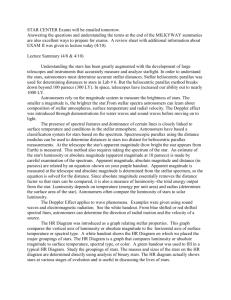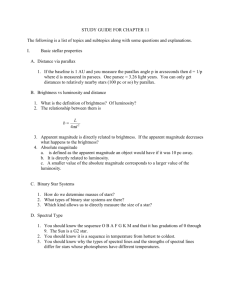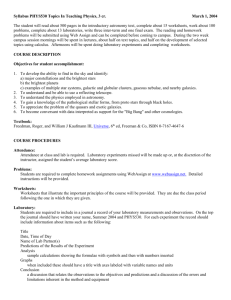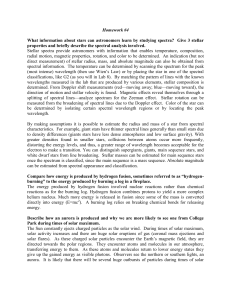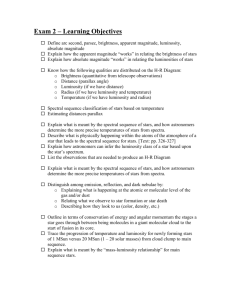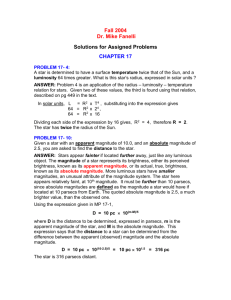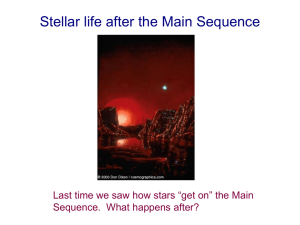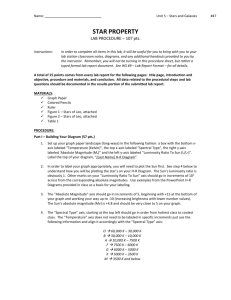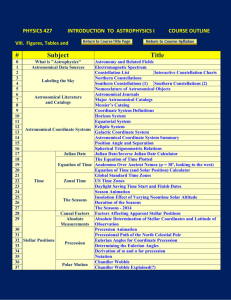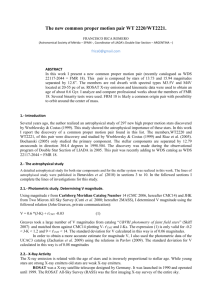It is evident from our observations of impact craters on planets and
advertisement
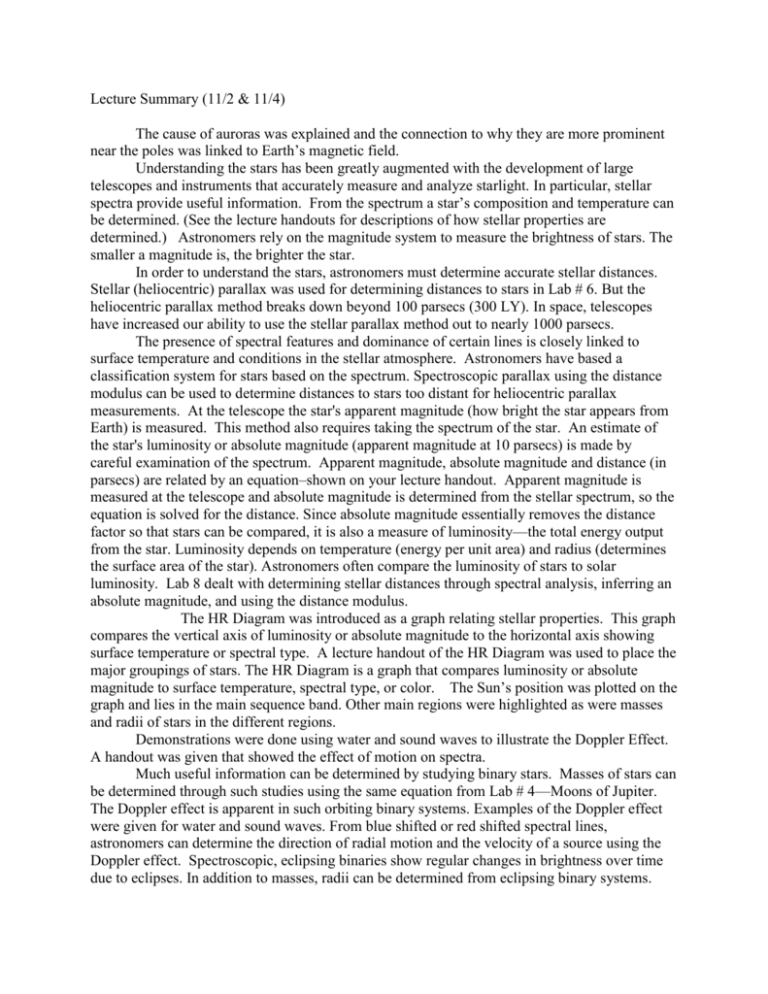
Lecture Summary (11/2 & 11/4) The cause of auroras was explained and the connection to why they are more prominent near the poles was linked to Earth’s magnetic field. Understanding the stars has been greatly augmented with the development of large telescopes and instruments that accurately measure and analyze starlight. In particular, stellar spectra provide useful information. From the spectrum a star’s composition and temperature can be determined. (See the lecture handouts for descriptions of how stellar properties are determined.) Astronomers rely on the magnitude system to measure the brightness of stars. The smaller a magnitude is, the brighter the star. In order to understand the stars, astronomers must determine accurate stellar distances. Stellar (heliocentric) parallax was used for determining distances to stars in Lab # 6. But the heliocentric parallax method breaks down beyond 100 parsecs (300 LY). In space, telescopes have increased our ability to use the stellar parallax method out to nearly 1000 parsecs. The presence of spectral features and dominance of certain lines is closely linked to surface temperature and conditions in the stellar atmosphere. Astronomers have based a classification system for stars based on the spectrum. Spectroscopic parallax using the distance modulus can be used to determine distances to stars too distant for heliocentric parallax measurements. At the telescope the star's apparent magnitude (how bright the star appears from Earth) is measured. This method also requires taking the spectrum of the star. An estimate of the star's luminosity or absolute magnitude (apparent magnitude at 10 parsecs) is made by careful examination of the spectrum. Apparent magnitude, absolute magnitude and distance (in parsecs) are related by an equation–shown on your lecture handout. Apparent magnitude is measured at the telescope and absolute magnitude is determined from the stellar spectrum, so the equation is solved for the distance. Since absolute magnitude essentially removes the distance factor so that stars can be compared, it is also a measure of luminosity—the total energy output from the star. Luminosity depends on temperature (energy per unit area) and radius (determines the surface area of the star). Astronomers often compare the luminosity of stars to solar luminosity. Lab 8 dealt with determining stellar distances through spectral analysis, inferring an absolute magnitude, and using the distance modulus. The HR Diagram was introduced as a graph relating stellar properties. This graph compares the vertical axis of luminosity or absolute magnitude to the horizontal axis showing surface temperature or spectral type. A lecture handout of the HR Diagram was used to place the major groupings of stars. The HR Diagram is a graph that compares luminosity or absolute magnitude to surface temperature, spectral type, or color. The Sun’s position was plotted on the graph and lies in the main sequence band. Other main regions were highlighted as were masses and radii of stars in the different regions. Demonstrations were done using water and sound waves to illustrate the Doppler Effect. A handout was given that showed the effect of motion on spectra. Much useful information can be determined by studying binary stars. Masses of stars can be determined through such studies using the same equation from Lab # 4—Moons of Jupiter. The Doppler effect is apparent in such orbiting binary systems. Examples of the Doppler effect were given for water and sound waves. From blue shifted or red shifted spectral lines, astronomers can determine the direction of radial motion and the velocity of a source using the Doppler effect. Spectroscopic, eclipsing binaries show regular changes in brightness over time due to eclipses. In addition to masses, radii can be determined from eclipsing binary systems. The interstellar medium (ISM) is comprised of gas and dust. Observations have been made that back the predictions made by the solar nebula theory. Dust affects starlight through dimming and reddening. TERMS: solar flares, coronal mass ejections, auroras, stellar parallax, apparent magnitude, absolute magnitude, main sequence star, giant, white dwarf, supergiant, spectral type, luminosity, distance modulus, spectroscopic parallax, HR Diagram, solar mass, solar radius, solar luminosity, Doppler effect, red shift, blue shift, binary stars, spectroscopic binaries, eclipsing binaries, interstellar medium, reddening QUESTIONS: 1. How are auroras produced? 2. Distinguish between apparent and absolute magnitude. 3. Why do the Sun and stars have absorption spectra? 4. What can astronomers learn by studying the spectra of stars? 5. How are the distances to stars determined? 6. Give alternate ways the axes of the HR Diagram may be labeled. 7. What does the phrase "the main sequence is really a mass sequence" mean? 8. How can a star hotter than the Sun be less luminous? (look at HR diagram) 9. How does radial motion affect spectral lines? 10. How do astronomers use the Doppler effect in the study of binary stars?
